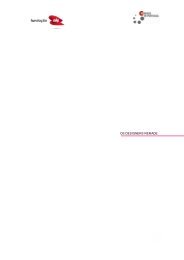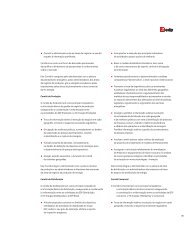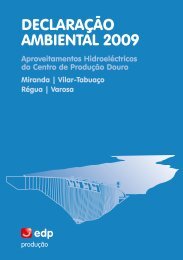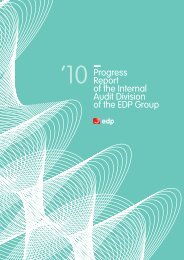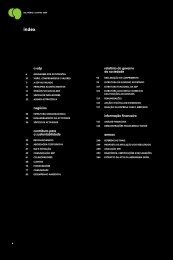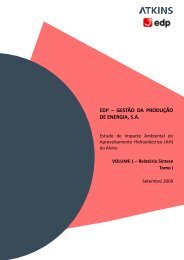Annual Report - EDP
Annual Report - EDP
Annual Report - EDP
- No tags were found...
Create successful ePaper yourself
Turn your PDF publications into a flip-book with our unique Google optimized e-Paper software.
notes to the <strong>EDP</strong> consolidated - Energias de Portugal, and company S.A. financial statementsNotes to for the the Consolidated years and ended Company 31 december Financial Statements 2012 and 2011for the years ended 31 December 2012 and 2011Negative goodwill arising on an acquisition is recognised directly in the income statement in the period the business combination occurs.The recoverable amount of the goodwill in subsidiaries is assessed annually, regardless of the existence of any impairment triggers. Impairment losses arerecognised in the income statement. The recoverable amount is determined based on the value in use of the assets, calculated using valuation methodologiessupported by discounted cash flow techniques, considering market conditions, the time value of money and the business risks.Until 31 December 2009, contingent acquisition prices were determined based on the best estimate of probable future payments, being the future changes in theestimate booked against goodwill. As from 1 January 2010, goodwill is no longer adjusted due to changes in the initial estimate of the contingent purchase price andthe difference is booked in the income statement.Purchases of non-controlling interests and dilutionUntil 31 December 2009, in the acquisition of non-controlling interests, the difference between the fair value of the non-controlling interests acquired and theconsideration paid, was accounted against goodwill. The acquisitions of non-controlling interests through written put options related with investments in subsidiariesheld by non-controlling interests, were recorded as a financial liability for the present value of the best estimate of the amount payable, against non-controllinginterests. The difference between the non-controlling interests acquired and the fair value of the liability, was recorded as goodwill. The fair value of the liability wasdetermined based on the contractual price which may be fixed or variable. In case of a variable price, the changes in the liability were recognised as an adjustment tothe cost of the business combination against goodwill and the effect of the financial discount of the liability (unwinding) was recognised as a financial expense in theconsolidated income statement. This accounting treatment is maintained for all options contracted until 31 December 2009.Until 31 December 2009, when an interest in a subsidiary was disposed, without a loss of control, the difference between the sale price and the book value of the netassets held by the Group, plus the carrying value of goodwill in that subsidiary, was recognised in the income statement of the period as a gain or loss resulting fromthe disposal. The dilution effect occurs when the percentage of interest in a subsidiary decreases without any sale of interest in that subsidiary, for example, if theGroup does not participate proportionally in the share capital increase of that subsidiary. Until 31 December 2009, the Group recognised the gains or losses resultingfrom a dilution of the interest in a subsidiary following a sale or capital increase, in the income statement.As from 1 January 2010 onwards, in an acquisition (dilution) of non-controlling interests not resulting in a loss of control, the difference between the fair value of the noncontrollinginterests acquired and the consideration paid, is accounted against reserves. The acquisitions of non-controlling interests through written put optionsrelated with investments in subsidiaries held by non-controlling interests, are recorded as a financial liability for the present value of the best estimate of the amountpayable, against non-controlling interests. The fair value of the liability is determined based on the contractual price which may be fixed or variable. In case of avariable price, the changes in the liability are recognised against the income statement as well as the effect of the financial discount of the liability (unwinding).Investments in foreign operationsThe financial statements of the foreign subsidiaries and associates of the Group are prepared using their functional currency, defined as the currency of the primaryeconomic environment in which they operate. In the consolidation process, the assets and liabilities of foreign subsidiaries are translated into Euros at the officialexchange rate at the balance sheet date.Regarding the investments in foreign operations that are consolidated using the full consolidation method, proportionate or equity method, the exchange differencesbetween the amount of equity expressed in Euros at the beginning of the period and the amount translated at the official exchange rates at the end of the period, on aconsolidated basis, are booked against reserves.Foreign currency goodwill arising on the acquisition of these investments is remeasured at the official exchange rate at the balance sheet date directly againstreserves.The income and expenses of foreign subsidiaries are translated into Euros at the approximate exchange rates at the dates of the transactions. Exchange differencesfrom the translation into Euros of the net profit for the period, arising from the differences between the rates used in the income statement and those prevailing at thebalance sheet date are recognised in reserves.On disposal of a foreign subsidiary, the related exchange differences previously recognised in reserves, are accounted for in the income statement.Balances and transactions eliminated on consolidationInter-company balances and transactions, including any unrealised gains and losses on transactions between Group companies, are eliminated in preparing theconsolidated financial statements. Unrealised gains and losses arising on transactions with associates and jointly controlled entities are eliminated to the extent of theGroup's interest in those entities.c) Foreign currency transactionsForeign currency transactions are translated at the exchange rates at the dates of the transactions. Monetary assets and liabilities denominated in foreign currencyare translated into Euros at the exchange rates at the balance sheet date. These exchange differences arising on translation are recognised in the income statement.Foreign currency non-monetary assets and liabilities accounted for at historical cost are translated using the exchange rates at the dates of the transactions. Foreigncurrency non-monetary assets and liabilities stated at fair value are translated into Euros at the exchange rates at the dates the fair value was determined.d) Derivative financial instruments and hedge accountingDerivative financial instruments are recognised on the trade date at fair value. Subsequently, the fair value of derivative financial instruments is remeasured on aregular basis, being the gains or losses on remeasurement recognised directly in the income statement, except for derivatives designated as cash flow hedginginstruments. Recognition, in the income statement, of the resulting gains and losses on remeasurement of hedging derivatives depends on the hedge model used.The fair value of derivative financial instruments corresponds to their market value, when available, or is determined by external entities using valuation techniques.<strong>EDP</strong> - <strong>Annual</strong> <strong>Report</strong> 2012179







